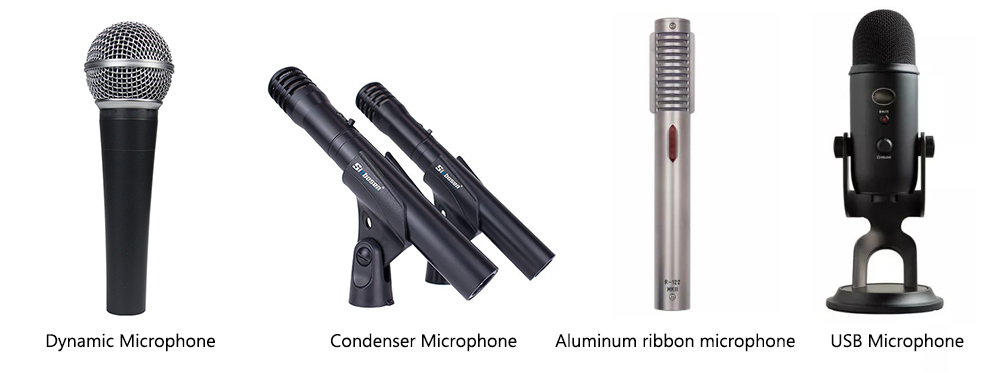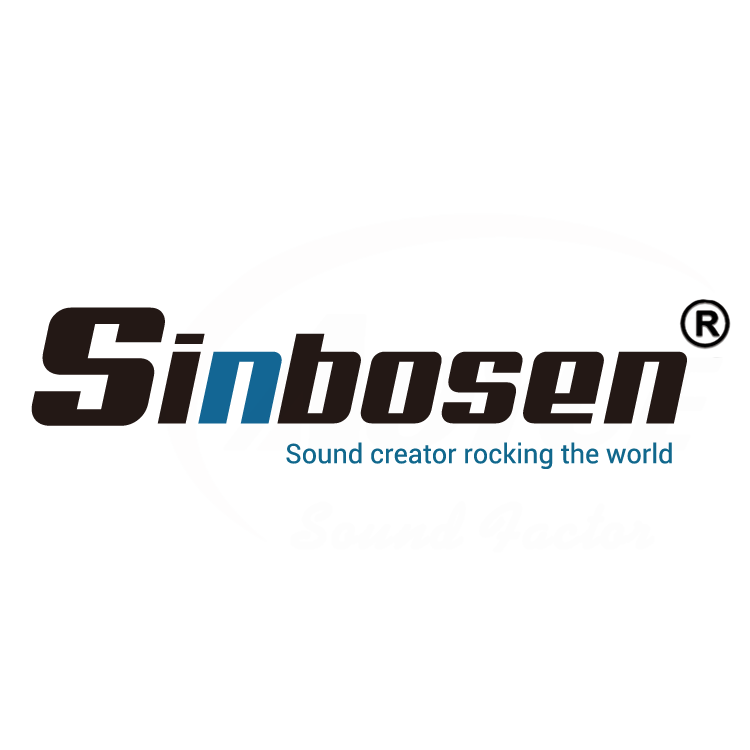How to choose a microphone that suits you?
Views : 10844
Update time : 2020-04-15 16:32:14
Many brands, many models, I don't know how to choose a microphone?
This problem is easily solved. As long as you have a basic understanding of microphone types and their uses, it is easy to choose a microphone that suits you and will provide you with a good recording experience.
Let ’s take a look at how to choose?
Sinbosen will introduce you to microphone knowledge from the following four points(This article will focus on 1.2 points, 3.4 points have another detailed introduction, click on the instructions to enter.)
1.Microphone type.
2. How to read the frequency response of a microphone.
3. Understand the directivity of the microphone.--What is the type and effect of microphone polar pattern?
4.Know the microphone diaphragm size.--What are the dimensions of a microphone diaphragm, and how do they differ?
 1.Microphone type
1.Microphone type
Dynamic microphone
For outdoor performances and indoor KTVs, the most commonly seen are dynamic microphones.
The principle is that the diaphragm in the microphone head drives the coil to vibrate, cutting the magnetic lines of force to generate electrical signals, and transmitting them to the next level of equipment through the microphone line.
Its advantages are simple structure, strong and durable, and cheap. Disadvantages are insufficient sensitivity, insufficient high-frequency response, and delicate tone.
Condenser microphone
The most widely used microphone in recording. The principle is to use a very thin metal diaphragm as the first stage of the capacitor and another metal backplane (a few tenths of a millimeter) close to it as the other pole. The vibration of the diaphragm will cause the capacitance to change, thereby forming an electrical signal. . Because the diaphragm is very thin, even small sounds can vibrate. Therefore, the condenser microphone is very sensitive and the price is relatively high.
If you want to learn more about dynamic microphones and condenser microphones, you can click here for more information.--Do you know the difference between dynamic microphone and condenser microphone?
Aluminum ribbon microphone
Widely used in the golden age of radio stations, it is similar to the principle of a dynamic microphone, but uses a small track / aluminum belt as the diaphragm to generate signals. It is characterized by warm sound, fast transient response, and natural mid- and low-frequency transitions; the disadvantage is that the high-frequency response is insufficient and relatively "fragile", so it must be carefully stored.
USB microphone
A USB microphone is a common microphone with a preamp, analog-to-digital converter (ADC), and headphone jack added inside the microphone. Think of it as a compact installation package with integrated microphone and interface. It does not have an XLR plug that can output microphone circuit signals, but has a USB plug.
The advantage is that there is no need for a sound card and no need to worry about phantom power, you can plug it directly into the computer; the disadvantage is that the sound quality cannot be compared with expensive professional microphones, and the built-in AD circuit is not comparable to professional microphones and sound cards.
2. How to read the frequency response of a microphone?
Reading the frequency response of the microphone is very helpful for choosing the microphone.
Theoretically, the frequency response map was generated after the factory passed the test of the microphone in the anechoic room. An anechoic room is a specially constructed room specifically for audio testing. Create a controlled environment where every microphone can be tested the same, the room has almost no sound, and no sound reflection of any kind.
So, how to read it?
The horizontal numbers in the frequency response graph represent frequencies (typically in the range of 20 Hz to 20 kHz), and the vertical numbers represent relative response (in dB) (decibels). When you look at the frequency response graph, you know the performance of the microphone at certain frequencies.
Let's take a look at the frequency response of a representative SM57:
The frequency response of SM57 makes it particularly suitable for certain instruments, such as snare drums, because the basic frequency of snare drums is in the range of 150Hz to 250Hz. The SM57 frequency response graph shows that the SM57 response is flat or neutral.
In other words, at this frequency, the sound recorded by the microphone is the original sound that your ears hear.
The existence of bumps on the right side of the chart is exactly where the snare drum “s” is. In addition, its low-end roll-off makes it ideal for eliminating kick drums that are usually close together. This combination is what most engineers seek in a great snare microphone-the ability to capture the true sound of a snare drum, enhance its playing power, and refuse to record other nearby instruments.
The above four points can help you better understand the microphone and make it easier to choose a microphone that suits you. If you have any questions, please contact us.
This problem is easily solved. As long as you have a basic understanding of microphone types and their uses, it is easy to choose a microphone that suits you and will provide you with a good recording experience.
Let ’s take a look at how to choose?
Sinbosen will introduce you to microphone knowledge from the following four points(This article will focus on 1.2 points, 3.4 points have another detailed introduction, click on the instructions to enter.)
1.Microphone type.
2. How to read the frequency response of a microphone.
3. Understand the directivity of the microphone.--What is the type and effect of microphone polar pattern?
4.Know the microphone diaphragm size.--What are the dimensions of a microphone diaphragm, and how do they differ?

Dynamic microphone
For outdoor performances and indoor KTVs, the most commonly seen are dynamic microphones.
The principle is that the diaphragm in the microphone head drives the coil to vibrate, cutting the magnetic lines of force to generate electrical signals, and transmitting them to the next level of equipment through the microphone line.
Its advantages are simple structure, strong and durable, and cheap. Disadvantages are insufficient sensitivity, insufficient high-frequency response, and delicate tone.
Condenser microphone
The most widely used microphone in recording. The principle is to use a very thin metal diaphragm as the first stage of the capacitor and another metal backplane (a few tenths of a millimeter) close to it as the other pole. The vibration of the diaphragm will cause the capacitance to change, thereby forming an electrical signal. . Because the diaphragm is very thin, even small sounds can vibrate. Therefore, the condenser microphone is very sensitive and the price is relatively high.
If you want to learn more about dynamic microphones and condenser microphones, you can click here for more information.--Do you know the difference between dynamic microphone and condenser microphone?
Aluminum ribbon microphone
Widely used in the golden age of radio stations, it is similar to the principle of a dynamic microphone, but uses a small track / aluminum belt as the diaphragm to generate signals. It is characterized by warm sound, fast transient response, and natural mid- and low-frequency transitions; the disadvantage is that the high-frequency response is insufficient and relatively "fragile", so it must be carefully stored.
USB microphone
A USB microphone is a common microphone with a preamp, analog-to-digital converter (ADC), and headphone jack added inside the microphone. Think of it as a compact installation package with integrated microphone and interface. It does not have an XLR plug that can output microphone circuit signals, but has a USB plug.
The advantage is that there is no need for a sound card and no need to worry about phantom power, you can plug it directly into the computer; the disadvantage is that the sound quality cannot be compared with expensive professional microphones, and the built-in AD circuit is not comparable to professional microphones and sound cards.
2. How to read the frequency response of a microphone?
Reading the frequency response of the microphone is very helpful for choosing the microphone.
Theoretically, the frequency response map was generated after the factory passed the test of the microphone in the anechoic room. An anechoic room is a specially constructed room specifically for audio testing. Create a controlled environment where every microphone can be tested the same, the room has almost no sound, and no sound reflection of any kind.
So, how to read it?
The horizontal numbers in the frequency response graph represent frequencies (typically in the range of 20 Hz to 20 kHz), and the vertical numbers represent relative response (in dB) (decibels). When you look at the frequency response graph, you know the performance of the microphone at certain frequencies.
Let's take a look at the frequency response of a representative SM57:
The frequency response of SM57 makes it particularly suitable for certain instruments, such as snare drums, because the basic frequency of snare drums is in the range of 150Hz to 250Hz. The SM57 frequency response graph shows that the SM57 response is flat or neutral.
In other words, at this frequency, the sound recorded by the microphone is the original sound that your ears hear.
The existence of bumps on the right side of the chart is exactly where the snare drum “s” is. In addition, its low-end roll-off makes it ideal for eliminating kick drums that are usually close together. This combination is what most engineers seek in a great snare microphone-the ability to capture the true sound of a snare drum, enhance its playing power, and refuse to record other nearby instruments.
The above four points can help you better understand the microphone and make it easier to choose a microphone that suits you. If you have any questions, please contact us.












